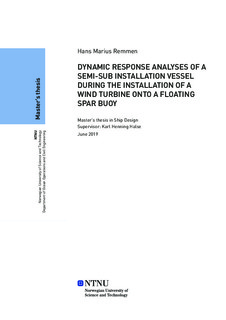| dc.contributor.advisor | Halse, Karl Henning | |
| dc.contributor.author | Remmen, Hans Marius | |
| dc.date.accessioned | 2019-10-03T14:00:27Z | |
| dc.date.available | 2019-10-03T14:00:27Z | |
| dc.date.issued | 2019 | |
| dc.identifier.uri | http://hdl.handle.net/11250/2620147 | |
| dc.description.abstract | Studien starter med en kort introduksjon til temaet marine operasjoner, med fokus på SSP teknologi og løfteoperasjoner. Det er mye informasjon om bruken av nedsenkbare plattformer i olje- og gassindustrien, men ikke så mye mot installasjon av flytende havvindmøller.
Et av forskningsspørsmålene er om en typisk SSP-plattform kan brukes som installasjonsplattform teknisk, og om bevegelsesegenskapene passer til formålet. Simulering ble valgt som forskningsmetode for denne studien for å analysere installasjonskonseptet.
For å utføre responsanalysene av de flytende objektene ble SIMA brukt. SIMA er et simuleringsverktøy for marine operasjoner med en overlegen hydrodynamisk modell i tidsdomene. Både SSP-modellen og sparmodellen ble importert til SIMA. Hydrodynamiske koeffisienter og modellegenskaper ble inkludert i de tilveiebragte SIMA-modellene, videre ble modellene importert til simuleringsmiljøet og koblinger/grensebetingelser ble definert.
Konseptmodellen ble simulert i flere miljøforhold - Nordsjøen ble valgt som installasjonssted. En kombinasjon av egenfrekvenser og scatter-diagram med de mest sannsynlige bølgehøyder / perioder ble brukt til å bestemme aktuelle bølgekondisjoner. SSP og spar total bevegelse med og uten koblinger ble analysert for å se effekten av forskjellige fysiske koblinger. Et av hovedmålene med konseptet var å redusere relativ bevegelse ved referansepunktet med sikte på å ha minimale kontaktkrefter mellom spar og OWT. Flere simuleringer ble utført i opprinnelig posisjon for å analysere forbedringen med forskjellige koblingsparametere. Analyser av kontaktkrefter i «docking cone» i senket posisjon ble også utført i forskjellige bølgekondisjoner. For å validere resultat ble det gjennomført sensitivitetsanalyser med bølgeretning 30 grader.
Totalt bevegelsesresultat fra SSP og spar viser at passive dempere, dempere mellom SSP og spar, har positiv effekt på responsen. «Surge» blir synkronisert, og spar «pitch» reduseres til et minimum. Vertikal relativ bevegelse reduseres i stor grad med kombinasjonene av den aktive «heave» kompensatoren (AHC) og de passive demperne. Det ble utført en separat parameteranalyse av parameterne for kompensatorkontrolleren - to forskjellige kontrollere ble adressert: PID og PD + FF. Etter installasjon av OWT og ingen spenning i løfte-wire, blir SSP introdusert for en 15 graders akterlig trim med inneværende ballastkondisjon. Et lite vannlinjeareal forårsaker høy lastfølsomhet som begrenser mulighetene. Forslag til dette problemet er å legge til store volumer mellom pongtonger og toppdekk for å øke vannlinjeareal, og en glidende masse under toppdekket ville forkorte total ballasteringstid.
Analyser, inkludert vindinduserte krefter, bør utføres og integrering av en kontroller for bevegelseskontroll for SSP i horisontalplan for å videreutvikle konseptet. | |
| dc.description.abstract | The paper starts with a brief introduction to the topic of marine operations, with focus on SSP technology and lifting operations. There are a lot of information regarding the use of a semi-sub in oil and gas industry, but not so extensive information regarding the installation of floating offshore wind turbines.
One of the main research questions is if a typical SSP platform can be used as installation platform technically, and if the motion characteristics suits the purpose. Simulation research method was chosen for this study to analyze the installation concept.
To conduct the response analyses of the floating objects SIMA was used. SIMA is a simulation tool for marine operations with a superior hydrodynamic model in time-domain. Both the SSP model and spar buoy model was imported into SIMA. Hydrodynamical coefficients and model characteristics were included in the provided SIMA models, further the models were imported into the simulation environment and physics were applied.
The concept model was simulated in multiple environmental conditions - the North Sea was chosen as installation site. A combination of natural frequencies and scatter diagram with the most probable wave heights/periods was used to determine simulation environments. SSP and spar total motion with and without couplings was analyzed to see the effect of different couplings. One of the major goals with the concept was to reduce relative motion at mating point with the intention to have minimal contact forces between spar and OWT. Multiple simulations were performed in initial position to analyze the improvement with different coupling parameters. Analyses of docking cone contact forces in lowered position was also conducted in different env. conditions. For result validation a sensitivity analyses with environmental heading 30 degrees was conducted.
Total motion result from the SSP and spar shows that passive dampers, damper between SSP and spar, have positive effect on the response. Surge motion gets synchronized and spar pitch motion is reduced to a minimum. Vertical relative motion is largely reduced with the combinations of the active heave compensator (AHC) and the passive dampers. A separate tuning of the heave compensator controller parameters was conducted – two different controllers where addressed: PID and PD + FF. After mating of the OWT and no tension in the lifting wires the SSP is introduced to a 15 degree aft trim with initial ballast. Small waterplane area causes high load sensitivity which limits the possibilities. Suggestions to this problem is to add buoyant volumes between pontoons and top deck to increase w.p. area, and a sliding mass underneath the top deck would shorten the ballasting time.
Analyses including wind induced forces should be performed and integration of a controller for OWT motion control in horizontal plane to further develop the concept. | |
| dc.language | eng | |
| dc.publisher | NTNU | |
| dc.title | DYNAMIC RESPONSE ANALYSES OF A SEMI-SUB INSTALLATION VESSEL DURING THE INSTALLATION OF A WIND TURBINE ONTO A FLOATING SPAR BUOY | |
| dc.type | Master thesis | |
